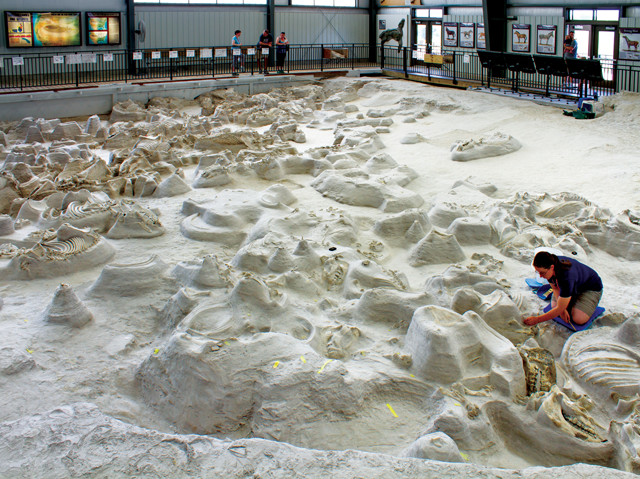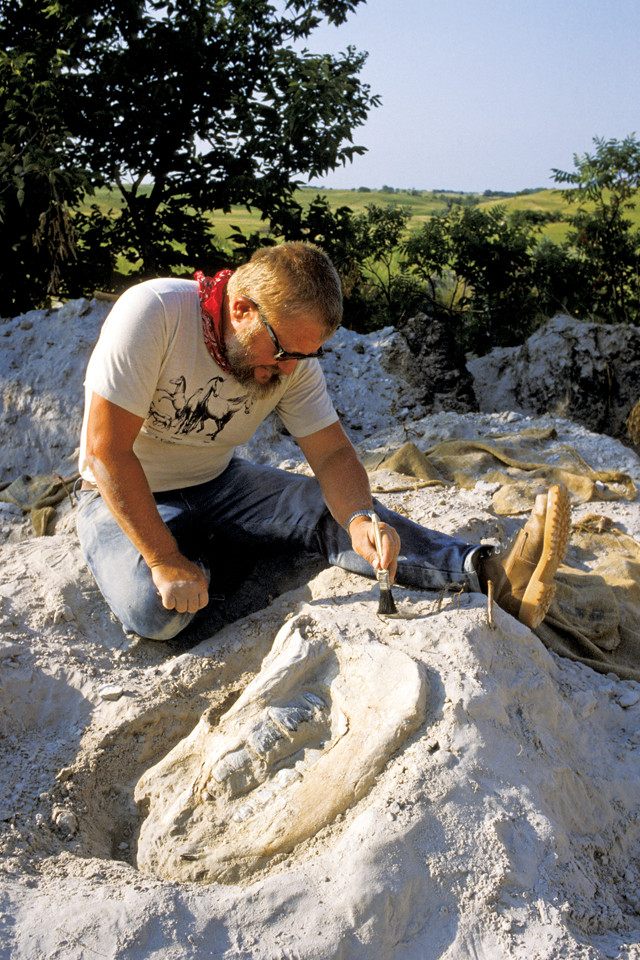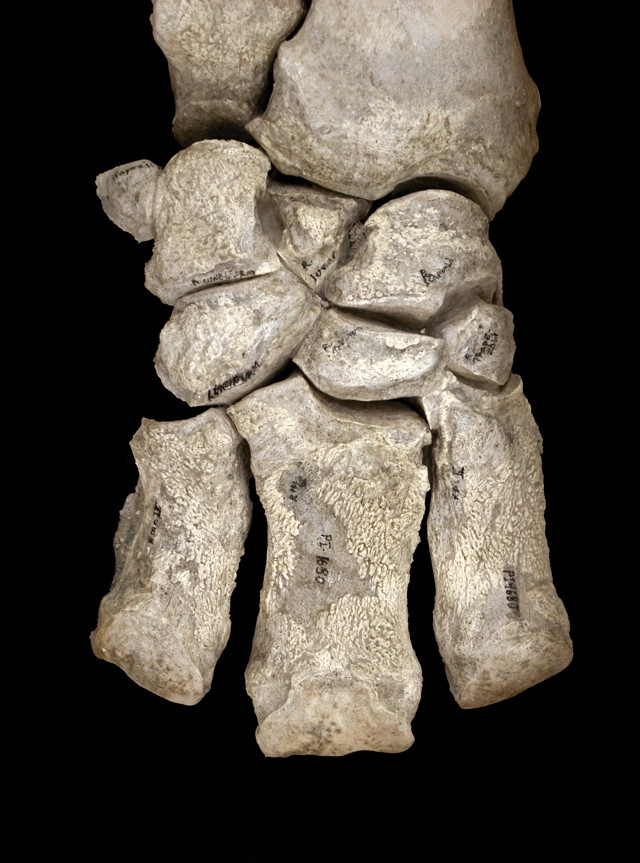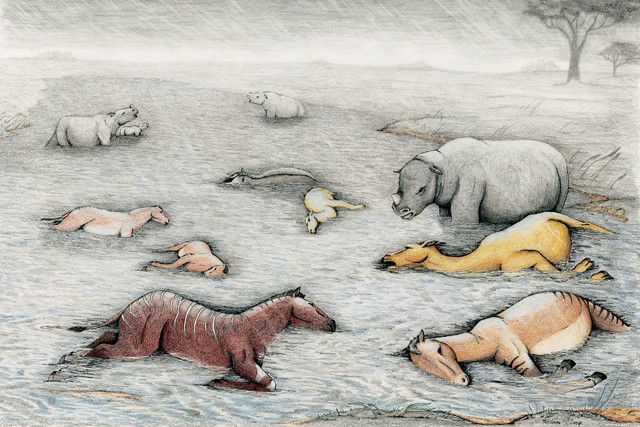
by Terri Cook Friday, May 19, 2017

The "Rhino Barn" at Nebraska's Ashfall Fossil Beds State Historical Park. Credit: University of Nebraska, Lincoln.
In the spring of 1971, paleontologist Mike Voorhies was mapping rock exposures on a farm in northeastern Nebraska when he wandered into a small ravine that recent heavy rains had swept clean of debris. High on the gully wall, a change in the color of the rock caught his eye, so he decided to scramble up and take a closer look.
“After wriggling through a narrow breach, Voorhies realized the tawny color that he’d seen from below was a freshly exposed layer of ash deposited by a volcanic eruption. Although this layer is present across much of western and central Nebraska, Voorhies noticed that it was unusually thick here, and that there was a white bone protruding from it.
As he began to brush away the surrounding, powdery grains, the paleontologist quickly realized that he had discovered an intact baby rhinoceros skull — the first he’d ever seen in his many years of hunting fossils in the area. But it wasn’t until six years later, when a crew from the University of Nebraska State Museum started probing the fossil-bearing layer, that Voorhies began to grasp the global significance of his discovery.
This month marks the 40th anniversary of the first excavation of this ash layer, now known to host one of the world’s most extraordinary fossil deposits. More extensive excavations, funded by the National Geographic Society, followed in the summers of 1978 and 1979. After removing several meters of overlying soil, sand and volcanic tuff, crews have since unearthed more than 200 spectacularly preserved skeletons of now-extinct animals, including barrel-bodied rhinos, three-toed horses, camels and saber-toothed deer, which exhibited elongated upper canine teeth, as some species of Asian deer still do today.
Unlike most fossil deposits, which contain scattered bone fragments from a limited number of animals, this ashbed, preserved since 1991 as part of the Ashfall Fossil Beds State Historical Park, is unique in that it hosts numerous articulated skeletons lying side by side in the bottom of a 3- to 4-meter-thick layer of pure volcanic ash. The large number of complete skeletons and their outstanding, three-dimensional preservation suggested to Voorhies and his colleagues that entire herds of animals had died together under remarkable circumstances.
Additional fieldwork divulged other tantalizing clues to the ancient tragedy, including large-hoofed mammal tracks in the underlying, sandy substrate that were filled with volcanic ash. From detailed mapping, and the localized presence of aquatic plant and animal fossils, the scientists learned that an especially thick pile of ash had settled into a large, bowl-shaped depression filled with water at the time of the animals’ deaths.
Collectively, the clues indicated that 12 million years ago, northeastern Nebraska was a lush, Serengeti-like savanna teeming with herds of exotic wildlife. Things changed quickly, however, when a cloud of ash from a massive volcanic eruption suddenly swept across these grasslands. As the cloud blew eastward, tiny shards of volcanic glass filled the air. Within hours, the abrasive, airborne ash killed the birds and other small animals whose remains were found at the very bottom of the ashbed.
Thanks to their greater lung capacities, the larger animals survived the initial dust storm, but the ash soon covered and destroyed their food supplies and filled their lungs. Many bones from the large- and medium-sized mammals found at the site have abnormally rough and porous patches on their surfaces, characteristics that are often pathologically associated with lung damage or disease. This evidence, along with scavenger bite marks on the skeletons of the medium-sized animals, suggests that the animals slowly suffocated over a period of weeks rather than hours or days.
As they suffered, hundreds of rhinos, camels, horses and other creatures sought relief from the ash at a local watering hole, where they slowly succumbed to the effects of the eruption. Their relative positions in the ashbed indicate that the largest creatures — the rhinos and giant tortoises — were the last to perish.
Like the citizens of Pompeii, the Roman city infamously buried in volcanic ash from the eruption of Mount Vesuvius in A.D. 79, the last moments of these creatures’ lives are frozen in time, offering heartbreaking glimpses into their untimely deaths. Young rhino calves have been found pressed up against females presumed to be their mothers, while other females were pregnant. Other creatures’ mouths and stomachs contain the fossilized remnants of their final meals.
Following the fossil beds’ discovery, geologists began searching for the source of the ash that filled this ancient northeastern Nebraska waterhole. Using fission-track dating, and more recently, the argon-40/argon-39 radiometric technique, researchers have narrowed the timing of the eruption to 11.93 million years ago.
Other studies compared the chemical composition of the Ashfall Fossil Beds ash with potential sources to the west, the direction of the prevailing winds. The results indicate the source was an enormous eruption in the Bruneau-Jarbidge volcanic field, located nearly 1,500 kilometers away in what is today southwestern Idaho.
Active from about 12.5 million to 10 million years ago, this volcanic field resulted from the Yellowstone hot spot, which produced a line of progressively younger volcanoes stretching from northeastern Nevada to northwestern Wyoming as the North American Plate moved across a stationary, rising magma plume. This volcanic province includes half a dozen enormous calderas — depressions created after each supervolcano erupted and the overlying material collapsed down into the empty magma chamber.

Paleontologist Mike Voorhies excavates at Ashfall Fossil Beds in 1987. Credit: NEBRASKAland Magazine/Nebraska Game and Parks Commission.
The youngest caldera in the chain, the Yellowstone Caldera in Yellowstone National Park, last erupted about 600,000 years ago and is about 48 kilometers across. The Bruneau-Jarbidge caldera, by comparison, is about 80 kilometers across, and the eruption responsible for creating it and the Ashfall Fossil Beds was about 1,000 times larger than the 1980 blast from Washington’s Mount St. Helens.
East of the eruptive center, more than half a meter of airborne ash fell to the ground as far away as central Wyoming, and one-third to one-half of a meter of ash fell across a large portion of the plains, including western and central Nebraska. The region’s steady winds then caused this ash to drift, filling in the Ashfall waterhole to a depth of several meters and covering the animals’ carcasses.
Thanks to their quick burial in volcanic ash and the lack of local disturbances, the Ashfall bones were fossilized in place and remained joined together, giving them a lifelike appearance that captivated the many locals who walked to the quarry to monitor the progress of the initial excavations. Motivated by the onlookers’ curiosity, Voorhies and his colleagues hatched a plan to develop the site into a working excavation accessible to the public, according to the book “Ashfall Fossil Beds: Present View of an Ancient Past,” which Voorhies co-authored.
In 1991, after years of planning and fundraising, the 145-hectare Ashfall Fossil Beds State Historical Park opened to the public. The centerpiece was a 185-square-meter “Rhino Barn,” where interns spent summers painstakingly excavating more of the ashbed. After 10 years, however, the entire surface within the barn was exposed. So, recently, a new and much larger enclosure, funded by the Hubbard family of Omaha, was built to protect new discoveries for many field seasons to come.

Many of the bones recovered from the ashbed show signs of hypertrophic osteopathy, or Marie's disease — abnormal bone growths that form when an animal dies slowly from lung failure. Credit: University of Nebraska State Museum.
“Although the spectacular skeletons of rhinos, three-toed horses and other large animals are the most photogenic finds, the ash from the supervolcano also preserved the remnants of many local flora, including tree and grass seeds. Together, these flora and fauna fossils have enabled researchers to reconstruct a “snapshot” of the entire Miocene ecosystem that once thrived here. From the hulls of grass seeds found in rhino stomachs and mouths, for example, researchers have determined the area was primarily covered by grasslands dotted with walnut and hackberry trees at the time of the eruption.
The fossils have also provided important insights into the regional climate at the time of the eruption. The presence of giant tortoises, cold-blooded animals that can’t survive for more than a few days when air temperatures hover near freezing, indicates that Nebraska’s mid-Miocene climate was warmer than today’s. Concentric growth rings in the fossilized tortoise shells further suggest that, like some modern species, these ancient tortoises experienced alternating periods of fast and slow growth that may reflect seasonal fluctuations in rainfall and/or temperature. This argument is bolstered by the information gathered from the site’s plant fossils, the vast majority of which come from grasses rather than trees, indicating that, at the time of the eruption, the region’s precipitation, like in modern savanna ecosystems, was limited to no more than 750 millimeters per year.
Thanks to the large number of skeletons of the same species found at the site, scientists have also been able to conduct population analyses, which provide much more information about the animals’ ecology than is possible from a few individuals. The absence of young male rhinos, for example, and the presence of one adult male for about every five females, suggest these animals may have been organized into harems. The presence of juvenile rhino skeletons next to adult females also suggests a family structure, and the similar ages of the young rhinos indicate that the animals likely had a fixed calving season.
Analyses of horse fossils (Pliohippus genus) found in the ashbed have revealed anatomical differences between species as well as within the same population. Some species had only one toe and no trace of side hooves, the anatomy most similar to modern horses, which excel at running across open grasslands. Others, like the members of the Hipparion genus, which became extinct in North America about 3 million years ago, had three toes — a central digit with a smaller toe on each side — and fully-developed side hooves, which protruded from each side of the main hoof and likely provided extra traction on softer ground, such as forest floors or marshy terrains.

Rhinos, camels, horses, birds and other animals suffering from the eruption sought relief at a watering hole. Their relative positions in the ashbed indicate that the largest creatures died last. Credit: artist Adrienne Stroup, courtesy of the University of Nebraska State Museum.
The horse fossils indicate that the Pliohippus genus was in a transitional state, with some individuals displaying functional side toes and others sporting side digits so small that they were anatomically useless. These differences suggest that 12 million years ago, at least some of the Ashfall lineages, as a result of the drying climate, were in the process of adapting to the expanding grasslands, where the harder ground reduced the side toes’ usefulness to such an extent that, over succeeding generations, they eventually disappeared.
If not for a fortuitous set of circumstances — from the eruption and extraordinary fossil preservation to Voorhies’ discovery and grassroots advocacy to create a public park — this rare example of evolution in action would not be available for the public to learn from and admire.
Excavations continue each summer, offering interns and the public the opportunity to experience the same painstaking labor, as well as the thrill of discovery, experienced 40 years ago by Mike Voorhies and the original excavation team.
Ashfall Fossil Beds State Historical Park was designated a U.S. Department of the Interior National Natural Landmark on May 9, 2006.
© 2008-2021. All rights reserved. Any copying, redistribution or retransmission of any of the contents of this service without the expressed written permission of the American Geosciences Institute is expressly prohibited. Click here for all copyright requests.